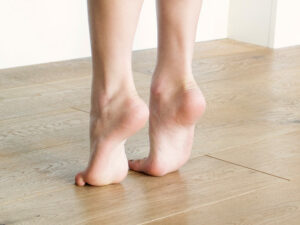Do you suffer from plantar fasciitis? If so, you know how painful and frustrating it can be. The good news is that there are exercises that can help relieve the pain. In this guide, we will discuss the best plantar fasciitis exercises and how to perform them correctly. We will also provide a few tips on how to prevent this condition from occurring in the first place. Let’s get started!
Contents
What Is Plantar Fasciitis?
 Plantar fasciitis is an inflammation of the plantar fascia, a thick band of tissue connecting the heel bone to the toes. The plantar fascia helps support the foot arch and acts as a shock absorber during activities such as walking or running.
Plantar fasciitis is an inflammation of the plantar fascia, a thick band of tissue connecting the heel bone to the toes. The plantar fascia helps support the foot arch and acts as a shock absorber during activities such as walking or running.
This condition is a common cause of heel pain and can be very painful. It is usually worse in the morning when you first get out of bed. The pain typically eases as you walk around, but it may return after long periods of standing or after rising from a seated position.
There are some common signs that you may have plantar fasciitis, which include:
- Heel pain that is worse in the morning or after periods of sitting
- Pain that increases with activity
- Swelling or tenderness in the heel
- Difficulty flexing your foot
There are a number of different treatments for plantar fasciitis, but exercises are often recommended as the first line of treatment. So, there are a number of different plantar fasciitis exercises that you can try, but it’s important to consult with your doctor or physical therapist before starting any new exercise program.
What Are Some Plantar Fasciitis Exercises?
There are a number of plantar fasciitis exercises that can help alleviate pain and promote healing. Some of the most common and effective exercises include:
Heel stretches
It is important to stretch the calf muscles and the plantar fascia itself to reduce pain and promote healing. There are a number of ways to stretch these areas, including:
- grabbing the toes and pulling back towards the leg,
- using a towel to pull the toes back towards the leg,
- dangling the foot over the edge of a step and letting gravity stretch the foot.
This type of exercise is typically done multiple times per day, for 30 seconds to a minute at a time.
Calf raises
Strengthening the calf muscles can help take some of the strain off of the plantar fascia and reduce pain. This can be done by doing calf raises, either with or without weight. For example, standing calf raises can be done by holding a weight in one hand and raising up onto the balls of both feet, then lowering back down. For doing this plantar fasciitis exercise, you can:
- Start with 3 sets of 10 repetitions and increase as tolerated
- Hold onto a railing or other support if needed
- Do one-legged calf raises by holding onto something for balance and raising up on one foot at a time
Toe stretches
The plantar fascia attaches to the toes, so it’s important to stretch them out as part of your plantar fasciitis exercise routine. This will help to lengthen the fascia and relieve tension.
To do a toe stretch:
- Sit in a chair with your feet flat on the floor.
- Use your hands to pull your big toe away from your second toe.
- Hold the stretch for 15-30 seconds.
- Repeat with your other foot.
It is believed that toe stretches can be particularly helpful in treating plantar fasciitis because they help to lengthen the Achilles tendon, which is connected to the plantar fascia.
Achilles tendon stretches
 It is important to stretch the Achilles tendon and the calf muscles to help plantar fasciitis. The following stretches can help:
It is important to stretch the Achilles tendon and the calf muscles to help plantar fasciitis. The following stretches can help:
- Heel drops: Stand with the balls of your feet on a step and your heels hanging off the edge. Slowly lower your heels below the level of the step, then raise back up. Do 2 sets of 10 reps.
- Towel stretches: Sit on the floor with your legs extended in front of you. Place a towel around the ball of your foot and gently pull the towel towards you while keeping your leg straight. Hold for 30 seconds and repeat 3 times.
Arch support exercises
Finally, plantar fasciitis exercises can also help to strengthen the arch of your foot. This in turn can help to take some of the strain off of the plantar fascia and may help to prevent or reduce pain. There are some arch support exercises specific to plantar fasciitis that you can try.
- One simple arch support exercise is to roll a tennis ball under your foot. You can do this while seated or standing, and you should roll the ball from your heel to your toes.
- Another easy arch support exercise is to simply clench and release your toes repeatedly. This helps to stretch and strengthen the muscles in your feet and can be done anywhere, anytime.
All in all, these are a few of the best plantar fasciitis exercises that you can try in order to find relief from pain. Remember to talk to your doctor before starting any new exercise routine, and always listen to your body. If an exercise is causing you pain, stop immediately. With a little bit of trial and error, you should be able to find the perfect exercises for you and your needs.
How To Do These Exercises Efficiently?
 Now that you know which exercises can help in getting rid of plantar fasciitis, it is time to learn how to do them correctly. Remember that while these exercises are helpful, they will not work if they are not done properly. Here are some pointers to keep in mind:
Now that you know which exercises can help in getting rid of plantar fasciitis, it is time to learn how to do them correctly. Remember that while these exercises are helpful, they will not work if they are not done properly. Here are some pointers to keep in mind:
- When stretching the calf muscles, be sure to do so gently. Do not overdo it as this can aggravate the condition.
- When performing the toe curls, be sure to curl only the affected toes. Do not try to curl all the toes at once as this will put unnecessary strain on the plantar fascia.
- When doing the ankle circles, be sure to keep the circles small. Do not try to make them too big as this will again put unnecessary strain on the plantar fascia.
- Remember to warm up before doing any of these exercises. A simple way to do this is to walk around for a few minutes before starting the exercises.
- Do not forget to cool down after completing the exercises. This can be done by walking around for a few minutes or by stretching the muscles again.
- Repeat the exercises 3-5 times per week for the best results.
These tips will help ensure that you are doing the exercises correctly and getting the most out of them. Remember, while these exercises are helpful, they will not work if they are not done properly. Be sure to follow the tips above to get the most out of these exercises. Because things work when done correctly.
What Is The Quickest Way To Get Rid Of Plantar Fasciitis?
Plantar fasciitis is a condition that can cause heel pain and discomfort. The condition is caused by the inflammation of the plantar fascia, which is a band of tissue that runs along the bottom of the foot. This is not an injury that should be ignored as it can lead to long-term pain and discomfort. There are many ways to treat plantar fasciitis, but exercises are often the best option.
The quickest way to get rid of plantar fasciitis is to rest, ice, and stretch the affected area. You can also take over-the-counter anti-inflammatory medication to help reduce the pain and inflammation. However, these methods only provide temporary relief and will not cure the condition.
Exercises are often the best way to reduce the symptoms of plantar fasciitis and improve the long-term health of the foot. There are a variety of exercises that can be done to stretch and strengthen the foot muscles and tissues. These exercises can help to take the pressure off of the plantar fascia and reduce pain and inflammation.
So, if you find relief with one of the quickest way methods but the pain continues, it’s time to consider some exercises. Because of this condition, you need to find a long-term solution to get rid of plantar fasciitis for good.
What Are The Benefits Of Plantar Fasciitis Exercises?
 There are various benefits of plantar fasciitis exercises, which include:
There are various benefits of plantar fasciitis exercises, which include:
- Help to stretch the plantar fascia and Achilles tendon, reducing tension and pain in the feet.
- Improve circulation in the feet, which helps to reduce inflammation.
- Help to strengthen the muscles in the feet and lower legs, improving support for the feet.
- Improves balance and proprioception (sense of position) in the feet, helping to prevent further injury.
- Increases range of motion in the feet and ankles.
It is important to note that plantar fasciitis exercises should be performed under the guidance of a qualified healthcare professional, as some exercises may actually worsen the condition if not done correctly. Exercises should be started slowly and increased gradually as tolerated.
Can You Prevent Plantar Fasciitis?
There are several things you can do to prevent plantar fasciitis or ease the pain if you already have it.
- Stretch your Achilles tendon and calf muscles before you run or exercise. A warm-up helps, too.
- Exercise within your fitness level and don’t try to do too much too soon.
- Wear shoes that have good arch support and cushioning. Replace your running shoes before they get worn out.
- If you’re overweight, lose weight.
- If you stand for long periods of time, take breaks.
- If you have flat feet or high arches, get custom arch supports.
- Don’t wear worn-out shoes.
- Switch your exercise routine. Doing the same workout every day can cause overuse injuries.
- Take it slow when you increase the intensity or duration of your workouts.
- Warm up before you exercise and cool down afterward.
- Try not to walk or run on hard surfaces like concrete for long periods of time.
These are a few things that can help prevent plantar fasciitis. It is important to understand that plantar fasciitis is a condition that can take time to heal. It is important to be patient and follow the above guidelines. Prevention is always the best medicine.
Therefore, if you follow the above guidelines, you can help prevent plantar fasciitis, or at least ease the pain if you already have it. So do not wait until the pain becomes unbearable. Take action now and get on the road to recovery!
Conclusion
In conclusion, plantar fasciitis exercises are often the key to successful treatment. However, it is important to note that not all exercises are appropriate for all patients. As such, it is important to consult with a healthcare professional prior to beginning any new exercise regimen. Additionally, those suffering from plantar fasciitis should be sure to warm up and cool down properly before.
With proper care and guidance, this condition can be effectively managed and even cured. So do not lose hope, and get started on your road to recovery today!
Physical Therapy help patients recover from pain. If you’re experiencing Back pain, Shoulder pain, Knee pain, Neck pain, Elbow pain, Hip pain, or Arthritis pain, a physical therapist at MantraCare can help: Book a physio therapy session.


